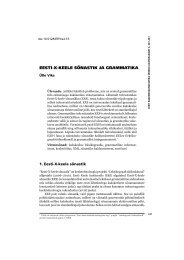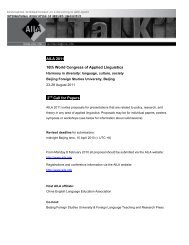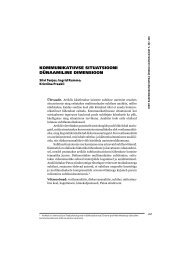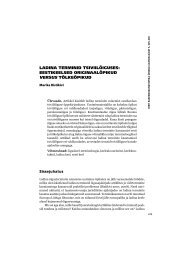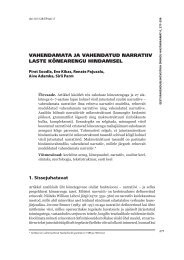ACQUISITION OF CASE IN LITHUANIAN AS L2: ERROR ANALYSIS
ACQUISITION OF CASE IN LITHUANIAN AS L2: ERROR ANALYSIS
ACQUISITION OF CASE IN LITHUANIAN AS L2: ERROR ANALYSIS
You also want an ePaper? Increase the reach of your titles
YUMPU automatically turns print PDFs into web optimized ePapers that Google loves.
in nature and their aim is to observe the learners’ language development and try to<br />
explain how it changes over time, and identify general tendencies (Ellis 1997).<br />
In literature a number of external and internal factors have been mentioned<br />
to explain why errors are made. They include the inuence of the social learning<br />
environment, the input, the stages of the learning process, the knowledge of the<br />
native tongue, the learning strategies, the communicative skills, the individual<br />
learner differences and instruction (Kaplan 2002, Savickien" 2006).<br />
All the levels (phonetics, lexis, morphology, pragmatics and grammar) of<br />
the language are important for the learner. Learning is a complex and dynamic<br />
process as a learner, interacting with a new environment, learns more and more<br />
new things. Constant and consistent storing of information and knowledge<br />
enables a qualitative and quantitative change in the learner’s language skills. Starting<br />
with the simplest and most common structures, the learner constantly integrates<br />
more difcult linguistic features into his/her language system. To achieve a certain<br />
linguistic competence the learner has to pass through several stages (Ellis 1997,<br />
Mitchell, Myles 1998, Savickien" 2003a). Thus errors in the learning process are a<br />
natural phenomenon and a result of the learning process that signal the learner’s<br />
progress.<br />
While learning a language, grammar is essential for good results in linguistic<br />
accuracy (Hinkel, Fotos 2002). The experience of teaching Lithuanian as a foreign<br />
language has shown that speakers of languages with a so-called poor morphology<br />
(for example, English, German, French, etc. as compared to Lithuanian) nd it<br />
more difcult to learn Lithuanian as a rich morphology language with a complex<br />
morphological structure (Savickien" 2003b). Therefore students make more errors<br />
either because of their native language inuence or due to the English language,<br />
which is the language of instruction during their Lithuanian classes. Moreover,<br />
English is most often used by Lithuanian language learners after the classes as a<br />
lingua franca.<br />
2. Research methods and data<br />
48<br />
The initial research aims were to investigate what students actually acquire when<br />
learning Lithuanian as a foreign language, and how students learn certain grammatical<br />
categories (in this paper, cases and declension paradigms). Furthermore,<br />
we attempted to classify the students’ errors and to explain the reasons for making<br />
them in order to reveal the tendencies of how Lithuanian as a foreign language is<br />
learnt. We expected that this research would improve our chances to explain the<br />
grammatical structure of Lithuanian to our future students.<br />
The error analysis research was carried out at Vytautas Magnus University. It<br />
is also based on non-systematic teacher’s observations over a long period of teaching<br />
practice. The data consists of beginner to advanced level summer course (one<br />
month duration) or exchange (one or two semesters’ duration) students’ written<br />
assignments. The error analysis is based on fty assignments of twenty exchange<br />
students, male and female, 20 to 54 years of age. The written assignments included<br />
letters, stories, recipes, and the students’ opinions on different topics. The focus of<br />
the research was on errors related to the use of noun case and declension paradigms.<br />
In this paper errors are considered to be the instances that do not comply with the



